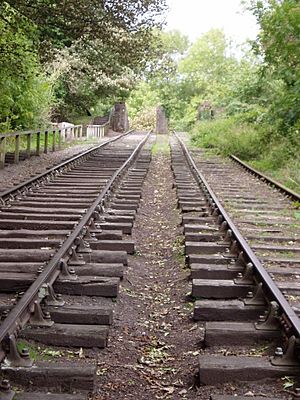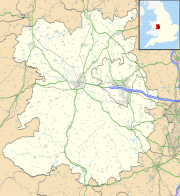Hay Inclined Plane facts for kids
The Hay Inclined Plane was a special kind of "boat lift" in the Ironbridge Gorge in Shropshire, England. Imagine a giant ramp that helped boats move up and down hills! It was 207 feet (about 63 meters) tall. This amazing machine was part of the Shropshire Canal system. These canals connected factories and mines in east Shropshire to the River Severn, which was like a superhighway for boats.
The Hay Inclined Plane worked from 1793 until 1894. Today, you can visit it at the Blists Hill Victorian Town, which is a museum where you can see what life was like in Victorian times. It's also a stop on the South Telford Heritage Trail.
Contents
History of the Hay Inclined Plane
Building the Boat Lift
In 1788, the people who owned the Shropshire Canal held a contest. They wanted to find the best way to move heavy goods and boats between the canal and the River Severn. A design by Henry Williams and James Loudon won. Their design was also used for other boat lifts in the area. The Hay Inclined Plane was finished in 1793.
Repairs and Changes Over Time
By 1820, the boat lift needed a lot of repairs. More repairs were done in the 1940s. In 1857, a railway company called the London and North Western Railway took over the Hay Inclined Plane. The next year, they closed parts of the Shropshire Canal. This left only a short section of the canal to serve the industrial area of Blists Hill.
In 1861, the railway company opened a new train line, the Coalport branch line. This line went from Wellington to Coalport and even passed underneath the Hay Inclined Plane!
Closing and Restoration
The last time the Hay Inclined Plane was used was probably in 1894. It was officially closed in 1907. But don't worry, it wasn't forgotten! It was fixed up in 1968 and again in 1975. This was part of creating the Ironbridge Gorge Museums, which help people learn about the area's history. The rails were even put back in place!
How the Hay Inclined Plane Worked
Special Boats and Tracks
The Shropshire Canal used special box-shaped boats called tub boats. These boats were about 20 feet (6 meters) long and could carry 5 tons of goods. The Hay Inclined Plane had two railway tracks going down the ramp. The tub boats would ride up and down on wheeled cradles that ran on these tracks.
At the bottom of the ramp, the tracks went underwater. This allowed the cradle to sink so the boat could float off or be floated into place. At the top, the tracks also started underwater. Then, they climbed a short slope out of the water to the top of the ramp.
Moving Boats Up and Down
Here's how it worked:
- An empty boat would be put into the cradle at the bottom.
- A full boat would be put into the cradle at the top.
- A rope would pull the loaded top cradle out of the water using a small winding drum. A steam engine powered this drum.
- Then, the main rope would be attached to the cradle. The loaded boat would go down the ramp.
- As the loaded boat went down, an empty boat on the other track would come up. This helped balance the weight.
- A brake on the winding drum controlled the speed.
- When the cradle reached the top, another rope from the small winding drum would guide it into the upper basin.
The Steam Engine's Role
Even though the loaded boats mostly went downhill by gravity, a small steam engine was still needed. It drove the winding drums. This engine was designed by Adam Heslop. You can still see the remains of the brick boiler house and the winding parts at the top of the ramp.
This whole system was run by four men. It took about four minutes to move a boat up or down the plane.
Images for kids
-
Coalport Canal at the bottom of the plane






